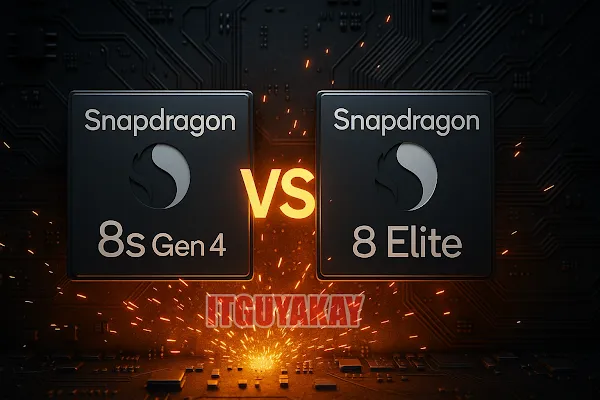The silicon war is heating up—and Qualcomm is at the center of it. With the release of the Snapdragon 8s Gen 4 and the power-packed Snapdragon 8 Elite, it’s a showdown that tech enthusiasts, mobile gamers, and AI aficionados can’t afford to ignore. While both chipsets offer cutting-edge features, they target slightly different user bases and device classes.
So which chip deserves a spot in your next smartphone? Let’s break it down, category by category.
Fabrication & CPU Architecture
Snapdragon 8 Elite: This beast is built on the 3nm TSMC process—a leap forward in efficiency and power. It uses Qualcomm’s custom Oryon cores, designed to deliver unmatched performance. You’re looking at speeds up to 4.47GHz with prime-performance hybrid cores. It’s not just fast—it’s brutally efficient.
Snapdragon 8s Gen 4: Don’t underestimate this chip either. It’s fabricated on a 4nm process, which still offers great power management. It comes with a more traditional 1+4+3 configuration using the Cortex-X4 and Cortex-A720 cores, peaking at 3.2GHz.
Critic’s Take: The 8 Elite is clearly the flagship muscle. The custom Oryon architecture is a game-changer, bringing laptop-level performance to your phone. The 8s Gen 4, however, is a more balanced approach—solid power without overkill.
GPU and Gaming
Snapdragon 8 Elite: Equipped with the Adreno 830 GPU, this chip screams high-end gaming. It’s based on a 3-slice architecture, pushing up to 40% better performance than its predecessor. Features like hardware-level ray tracing, Game Super Resolution 2.0, and support for Unreal Engine 5.3 make it a mobile gamer’s dream.
Snapdragon 8s Gen 4: This one sports the Adreno 825, still powerful, with support for ray tracing and adaptive performance, but lacks the elite enhancements like Frame Motion Engine and some Unreal 5 features.
Critic’s Take: If gaming is your battlefield, the 8 Elite dominates with ease. The 8s Gen 4 is respectable, but it won’t handle the ultra settings as fluidly under sustained load.
AI and NPU (Neural Processing Unit)
Snapdragon 8 Elite: Qualcomm’s AI engine in the Elite is a masterpiece. Supporting everything from INT4 to FP16 precision, it enables real-time translation, on-device personalization, AI-based video segmentation, and micro tile inferencing.
Snapdragon 8s Gen 4: Also AI-capable, it features similar INT4–INT8 support and enhanced memory, but lacks some of the Elite’s multi-modal AI features and real-time inferencing capabilities.
Critic’s Take: For future-ready AI on smartphones—from smart photography to AI voice assistants—the 8 Elite is the smarter brain.
Connectivity
Snapdragon 8 Elite: Armed with the Snapdragon X80 modem, it offers 10Gbps 5G, mmWave, Wi-Fi 7 via FastConnect 7900, Bluetooth 6.0, and even UWB (Ultra Wideband). Think of it as the Swiss Army knife of mobile connectivity.
Snapdragon 8s Gen 4: Comes with a respectable but slightly toned-down modem offering 4.2Gbps speeds, 4x4 MIMO, Wi-Fi 7, and Bluetooth 6.0—no UWB though.
Critic’s Take: Flagship phones deserve flagship connectivity. The 8 Elite is all-in, while the 8s Gen 4 trims the extras to keep costs in check.
Camera & Imaging
Snapdragon 8 Elite: Packs a punch with support for 320MP sensors, real-time object removal, semantic segmentation, ultra-low-light video, and Truepic-certified image authenticity.
Snapdragon 8s Gen 4: Limited to 200MP sensors, 4K@60 video capture, and Night Vision 2.0, it’s still impressive but lacks elite-level real-time imaging tools.
Critic’s Take: Content creators, vloggers, and camera-first users will find the 8 Elite the more versatile choice.
Display Support & Memory
Snapdragon 8 Elite: Supports QHD+ resolution at 240Hz, external 8K video output, and LPDDR5X RAM at 5300MHz.
Snapdragon 8s Gen 4: Capped at WQHD+ 144Hz, 4K external output, and LPDDR5X at 4200MHz.
Critic’s Take: It’s another win for the Elite, offering desktop-class visuals on mobile screens. The 8s Gen 4, again, makes a practical trade-off.
Efficiency & Use Case
Snapdragon 8 Elite: Thanks to its 3nm process and custom Oryon cores, it offers 44% better power efficiency—excellent for gaming, multitasking, and heavy AI without overheating or draining your battery.
Snapdragon 8s Gen 4: Also efficient, but with a 4nm node and stock architecture, it’s more suitable for premium mid-range or cost-optimized flagship killers.
Critic’s Take: For those who demand everything from their phones—be it editing 8K video or running LLMs—the Elite is your chip. The 8s Gen 4 is the smart choice for performance without a flagship price.
Verdict: Which Chip Should You Choose?
If you’re investing in a flagship phone that can replace your gaming console, camera, and laptop, the Snapdragon 8 Elite is the obvious pick. It’s built for the future—with unmatched power, advanced AI, professional-grade imaging, and top-tier connectivity.
But if you want 85% of the flagship experience at 60% of the price, the Snapdragon 8s Gen 4 is a brilliant compromise. It brings flagship-level performance, modern AI features, great battery life, and strong gaming—all while being kinder to your wallet.
Summary Comparison Table
| Feature | Snapdragon 8 Elite | Snapdragon 8s Gen 4 |
|---|---|---|
| Process | 3nm (TSMC) | 4nm |
| CPU Cores | Custom Oryon | Cortex-X4 + A720 |
| Max Clock Speed | 4.47GHz | 3.2GHz |
| GPU | Adreno 830 (3-slice) | Adreno 825 (2-slice) |
| AI Capabilities | FP16/INT4, multimodal | INT8/INT4, limited AI |
| 5G Modem | X80 (10Gbps, mmWave) | 4.2Gbps, no mmWave |
| Camera Support | 320MP, real-time AI | 200MP, basic AI tools |
| Display | QHD+ 240Hz, 8K output | WQHD+ 144Hz, 4K output |
| RAM Support | LPDDR5X @ 5300MHz | LPDDR5X @ 4200MHz |
| Use Case | Flagship-class | Premium mid-range |
Stay tuned as smartphones powered by both of these monsters already hit the market in 2025. Whether you’re a power user, gamer, or a creator, knowing what’s under the hood will help you make the smartest buy.











0 Comments